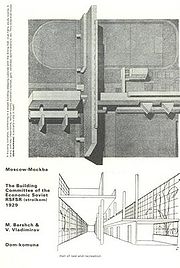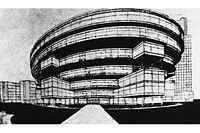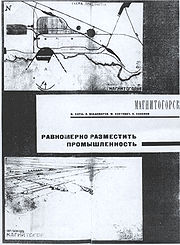
OSA Group
Encyclopedia

Soviet Union
The Soviet Union , officially the Union of Soviet Socialist Republics , was a constitutionally socialist state that existed in Eurasia between 1922 and 1991....
, which was active from 1925 to 1930 and considered the first group of constructivist architects
Constructivist architecture
Constructivist architecture was a form of modern architecture that flourished in the Soviet Union in the 1920s and early 1930s. It combined advanced technology and engineering with an avowedly Communist social purpose. Although it was divided into several competing factions, the movement produced...
. It published the journal SA (Sovremmennaia Arkhitektura or 'Contemporary Architecture').
Contemporary architecture

ASNOVA
ASNOVA was an Avant-Garde architectural association in the Soviet Union, which was active in the 1920s and early 1930s, commonly called 'the Rationalists'....
group, OSA grew out of the avant-garde wing of the VKhUTEMAS
VKhUTEMAS
Vkhutemas ) was the Russian state art and technical school founded in 1920 in Moscow, replacing the Moscow Svomas. The workshops were established by a decree from Vladimir Lenin with the intentions, in the words of the Soviet government, "to prepare master artists of the highest qualifications for...
school in Moscow
Moscow
Moscow is the capital, the most populous city, and the most populous federal subject of Russia. The city is a major political, economic, cultural, scientific, religious, financial, educational, and transportation centre of Russia and the continent...
. The group's founders were Moisei Ginzburg
Moisei Ginzburg
Moisei Yakovlevich Ginzburg was a Soviet constructivist architect, best known for his 1929 Narkomfin Building in Moscow.-Education:Ginzburg was born in Minsk in a Jewish real estate developer's family. He graduated from Milano Academy and Riga polytechnic institute . During Russian Civil War he...
, well-known for his book Style and Epoch (a Soviet response to Le Corbusier
Le Corbusier
Charles-Édouard Jeanneret, better known as Le Corbusier , was a Swiss-born French architect, designer, urbanist, writer and painter, famous for being one of the pioneers of what now is called modern architecture. He was born in Switzerland and became a French citizen in 1930...
's Vers une Architecture) and the painter, designer and architect Alexander Vesnin
Alexander Vesnin
Alexander Aleksandrovic Vesnin , together with his brothers Leonid Aleksandrovic Vesnin and Viktor Aleksandrovic Vesnin he was a leading light of Constructivist architecture...
. Unlike the earlier association the OSA group claimed for itself the name Constructivist, in that it was, in its utilitarianism and concentration on function rather than form, an architectural equivalent to the experiments of 'artistic' Constructivism
Constructivism (art)
Constructivism was an artistic and architectural philosophy that originated in Russia beginning in 1919, which was a rejection of the idea of autonomous art. The movement was in favour of art as a practice for social purposes. Constructivism had a great effect on modern art movements of the 20th...
. OSA was in many ways the architectural wing of the socialist Modernists of LEF
LEF (journal)
LEF was the journal of the Left Front of the Arts , a widely ranging association of avant-garde writers, photographers, critics and designers in the Soviet Union. It had two runs, one from 1923 to 1925 as LEF, and later from 1927 to 1929 as Novy LEF...
, and likewise set up its own journal in 1926.

Le Corbusier
Charles-Édouard Jeanneret, better known as Le Corbusier , was a Swiss-born French architect, designer, urbanist, writer and painter, famous for being one of the pioneers of what now is called modern architecture. He was born in Switzerland and became a French citizen in 1930...
, the Bauhaus
Bauhaus
', commonly known simply as Bauhaus, was a school in Germany that combined crafts and the fine arts, and was famous for the approach to design that it publicized and taught. It operated from 1919 to 1933. At that time the German term stood for "School of Building".The Bauhaus school was founded by...
, Fernand Léger
Fernand Léger
Joseph Fernand Henri Léger was a French painter, sculptor, and filmmaker. In his early works he created a personal form of Cubism which he gradually modified into a more figurative, populist style...
, and Kasimir Malevich (who was also a contributor to the journal). The design was mainly by Alexei Gan, who also designed the distinctive grid pattern of the covers. Photography was occasionally by Alexander Rodchenko
Alexander Rodchenko
Aleksander Mikhailovich Rodchenko was a Russian artist, sculptor, photographer and graphic designer. He was one of the founders of constructivism and Russian design; he was married to the artist Varvara Stepanova....
. As well as publishing on the built projects of Modernism, the journal published experimental projects by VKhUTEMAS students such as Lydia Komarova's Comintern project, the strange pod houses of Sokolov, and the works of Ivan Leonidov
Ivan Leonidov
Ivan Ilich Léonidov was a Russian constructivist architect, urban planner, painter and teacher.-Early life:...
. Articles in the journal was mainly in Russian, though occasionally parts of it were in German, highlighting the group's affinities with the Neues Bauen, although no OSA architects were invited to contribute to the Weissenhof Estate
Weissenhof Estate
The Weissenhof Estate is a housing estate built for exhibition in Stuttgart in 1927...
. The group was, however, the Soviet counterpart of Der Ring
Der Ring
Der Ring was an architectural collective founded in 1926 in Berlin. It emerged out of expressionist architecture with a functionalist agenda. Der Ring was a group of young architects, formed with the objective of promoting Modernist architecture. It took a position against the prevailing...
in Germany: agitating for Modern architecture and construction methods, and polemicising against the Classicism and Eclecticism that would eventually coalesce into Stalinist architecture
Stalinist architecture
Stalinist architecture , also referred to as Stalinist Gothic, or Socialist Classicism, is a term given to architecture of the Soviet Union between 1933, when Boris Iofan's draft for Palace of the Soviets was officially approved, and 1955, when Nikita Khrushchev condemned "excesses" of the past...
.
OSA activities

Yekaterinburg
Yekaterinburg is a major city in the central part of Russia, the administrative center of Sverdlovsk Oblast. Situated on the eastern side of the Ural mountain range, it is the main industrial and cultural center of the Urals Federal District with a population of 1,350,136 , making it Russia's...
, and most famously the Gostrakh and Narkomfin
Narkomfin Building
The Narkomfin Building is a block of flats in Moscow, designed by Moisei Ginzburg with Ignaty Milinis in 1928, and finished in 1932. Only two of four planned buildings were completed. The building is squeezed between old and new territories of United States Embassy at 25, Novinsky Boulevard...
buildings); the 1920s-'30s work of the Vesnin brothers
Vesnin brothers
The Vesnin brothers: Leonid Vesnin , Victor Vesnin and Alexander Vesnin were the leaders of Constructivist architecture, the dominant architectural school of the Soviet Union in the 1920s and early 1930s...
such as the Likhachev Palace of Culture and the Mostorg department store in Moscow, and the Ivanovo bank and DneproGES power station; works by Mikhail Barsch, such as Moscow Planetarium (with Sinyakvsky) and the Gostorg office block (as part of a team headed by Boris Velikovsky); works by Ivan Nikolaev
Ivan Nikolaev
Ivan Sergeevich Nikolaev was a Soviet architect and educator, notable for his late 1920s constructivist architecture and later work in industrial architecture....
, such as the electrical-technical complex in Moscow (with Fissenko; this work was featured in MOMA
Moma
Moma may refer to:* Moma , an owlet moth genus* Moma Airport, a Russian public airport* Moma District, Nampula, Mozambique* Moma River, a right tributary of the Indigirka River* Google Moma, the Google corporate intranet...
's 1932 International Style
International style (architecture)
The International style is a major architectural style that emerged in the 1920s and 1930s, the formative decades of Modern architecture. The term originated from the name of a book by Henry-Russell Hitchcock and Philip Johnson, The International Style...
exhibition) and the large collective house for the students in Moscow; and the workers' housing designed by Alexander Nikolsky in Tractor Street, Leningrad
Leningrad
Leningrad is the former name of Saint Petersburg, Russia.Leningrad may also refer to:- Places :* Leningrad Oblast, a federal subject of Russia, around Saint Petersburg* Leningrad, Tajikistan, capital of Muminobod district in Khatlon Province...
.
The OSA group's leading theorists were members of the CIAM
CIAM
CIAM may refer to:* Commission Internationale Aeromodelling, a section of Fédération Aéronautique Internationale* Congrès International d'Architecture Moderne, the International Congress of Modern Architecture...
from 1928 until 1933, with Ginzburg and Nikolai Kolli
Nikolai Kolli
Nikolai Dzhemsovich Kolli was a Russian Constructivist architect and city planner.Born in Moscow, Kolli studied at the Moscow School of Painting, Sculpture and Architecture and then at Vkhutemas...
members of its secretariat, CIRPAC. A small CIAM meeting with the OSA group was held in Moscow in 1932, with Sigfried Giedion
Sigfried Giedion
Sigfried Giedion was a Bohemia-born Swiss historian and critic of architecture....
and Cornelius van Eesteren in attendance. Sergei Eisenstein
Sergei Eisenstein
Sergei Mikhailovich Eisenstein , né Eizenshtein, was a pioneering Soviet Russian film director and film theorist, often considered to be the "Father of Montage"...
's The General Line featured specially built buildings by OSA's Andrey Burov. The utopian projects of Ivan Leonidov
Ivan Leonidov
Ivan Ilich Léonidov was a Russian constructivist architect, urban planner, painter and teacher.-Early life:...
were first published in SA, and their technologically advanced, fantastic nature led to harsh criticisms from the VOPRA group of Arkady Mordvinov
Arkady Mordvinov
Arkady Grigoryevich Mordvinov was a Soviet architect and construction manager, notable for Stalinist architecture of Tverskaya Street, Leninsky Avenue, Hotel Ukraina skyscraper in Moscow and his administrative role in Soviet construction industry and architecture.-VOPRA years:Mordvinov was born in...
and Karo Alabian, coining the phrase 'Leonidovism' to attack this 'Western' group: in a 1929 editorial SA trenchantly defended Leonidov, but this was a sign of what was to come, with Mikhail Barsch being targeted in an 'anti-bourgeois' campaign at VKhUTEMAS/VKhUTEIN.
From collective houses to disurbanism

Social condenser
From Soviet constructivist theory, the social condenser is a spatial idea practiced in architecture. At the opening speech for the first OSA Group conference in 1928 Moisei Ginzburg claimed that "the principal objective of constructivism...is the definition of the Social Condenser of the age." The...
. OSA architects were employed by the state to develop a standard for apartment buildings (the Stroikom apartments) for the purposes of mass production. However by 1929 there was a shift in the group's theory away from collective city blocks to 'disurbanism', perhaps influenced by the brutalities of forced collectivisation in the Soviet countryside. Mikhail Okhitovich
Mikhail Okhitovich
Mikhail Okhitovich was a Bolshevik sociologist, town planner and Constructivist architectural theorist, most famous for his 'Disurbanist' proposals of 1929-30....
's theories of using telecommunications, roads and infrastructure to create diffuse, semi-rural cities were published in SA, and the group's proposals for the new town of Magnitogorsk
Magnitogorsk
Magnitogorsk is a mining and industrial city in Chelyabinsk Oblast, Russia, located on the eastern side of the extreme southern extent of the Ural Mountains by the Ural River. Population: 418,545 ;...
were produced with his input, only to be defeated by Ernst May
Ernst May
Ernst May was a German architect and city planner.May successfully applied urban design techniques to the city of Frankfurt am Main during Germany's Weimar period, and in 1930 less successfully exported those ideas to Soviet Union cities, newly created under Stalinist rule...
of Der Ring. The 1930 debate over 'disurbanism' saw the OSA leadership (particularly Ginzburg) throw itself behind the theory, which had dire consequences when the movement was condemned by a Politburo statement. The journal was wound up in 1930, and OSA briefly became SASS (Section of Architects for Socialist Construction) before being merged into the state architecture union. The group's members continued to practice in a Modernist fashion until 1934 and the official ushering in of Socialist Realism
Socialist realism
Socialist realism is a style of realistic art which was developed in the Soviet Union and became a dominant style in other communist countries. Socialist realism is a teleologically-oriented style having its purpose the furtherance of the goals of socialism and communism...
. Most OSA members survived the great purge
Great Purge
The Great Purge was a series of campaigns of political repression and persecution in the Soviet Union orchestrated by Joseph Stalin from 1936 to 1938...
, with the exceptions of Alexei Gan and Mikhail Okhitovich, who were both murdered.
With the general rehabilitation of Modernism in the 1960s the issues of SA were reprinted, after decades of suppression.
Some OSA Members and other contributors to SA
- Alexander VesninAlexander VesninAlexander Aleksandrovic Vesnin , together with his brothers Leonid Aleksandrovic Vesnin and Viktor Aleksandrovic Vesnin he was a leading light of Constructivist architecture...
- Moisei GinzburgMoisei GinzburgMoisei Yakovlevich Ginzburg was a Soviet constructivist architect, best known for his 1929 Narkomfin Building in Moscow.-Education:Ginzburg was born in Minsk in a Jewish real estate developer's family. He graduated from Milano Academy and Riga polytechnic institute . During Russian Civil War he...
- Mikhail Barsch
- Andrey Burov
- Alexei Gan
- Ilya GolosovIlya GolosovIlya Alexandrovich Golosov was a Russian Soviet architect. A leader of Constructivism in 1925-1931, Ilya Golosov later developed his own style of early stalinist architecture known as postconstructivism...
- Panteleimon GolosovPanteleimon GolosovPanteleimon Alexandrovich Golosov was a Russian Constructivist architect and brother of Ilya Golosov.-Career:Golosov graduated from the Moscow School of Painting, Sculpture and Architecture in 1911. From 1918 he taught at the State Free Artist Studios , then at VKhUTEMAS and at the Moscow...
- Nikolai KolliNikolai KolliNikolai Dzhemsovich Kolli was a Russian Constructivist architect and city planner.Born in Moscow, Kolli studied at the Moscow School of Painting, Sculpture and Architecture and then at Vkhutemas...
- Lydia Komarova
- Le CorbusierLe CorbusierCharles-Édouard Jeanneret, better known as Le Corbusier , was a Swiss-born French architect, designer, urbanist, writer and painter, famous for being one of the pioneers of what now is called modern architecture. He was born in Switzerland and became a French citizen in 1930...
- Ivan LeonidovIvan LeonidovIvan Ilich Léonidov was a Russian constructivist architect, urban planner, painter and teacher.-Early life:...
- Kasimir Malevich
- Nikolai Krasilnikov
- Ivan NikolaevIvan NikolaevIvan Sergeevich Nikolaev was a Soviet architect and educator, notable for his late 1920s constructivist architecture and later work in industrial architecture....
- Alexander Nikolsky
- Mikhail OkhitovichMikhail OkhitovichMikhail Okhitovich was a Bolshevik sociologist, town planner and Constructivist architectural theorist, most famous for his 'Disurbanist' proposals of 1929-30....
- Alexander Pasternak
- Alexander RodchenkoAlexander RodchenkoAleksander Mikhailovich Rodchenko was a Russian artist, sculptor, photographer and graphic designer. He was one of the founders of constructivism and Russian design; he was married to the artist Varvara Stepanova....
- Varvara StepanovaVarvara StepanovaVarvara Fyodorovna Stepanova , was a Russian artist associated with the 'Constructivist' movement.She came from peasant origins but was fortunate enough to get an education at Kazan School of Art, Odessa. There she met her lifelong friend and collaborator Alexander Rodchenko...

